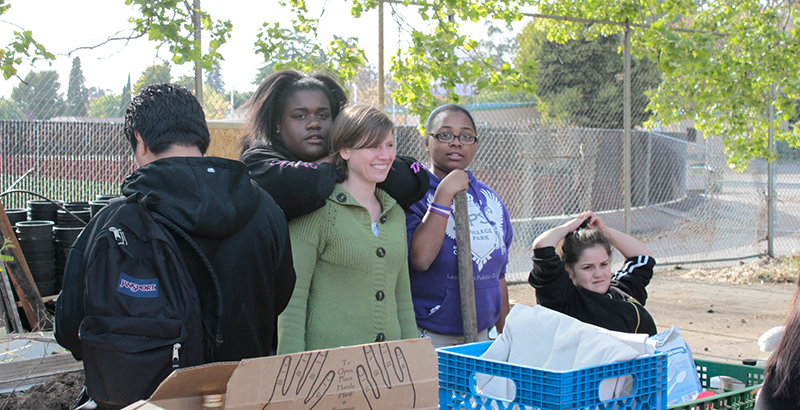74 Interview: Teaching Lab CEO Sarah Johnson on the Importance of One-on-One Interactions, What Not to Ask Students on the First Day of School, and Why Less Is More With Tech

See previous 74 interviews, including New York City Councilman and Education Committee Chair Mark Treyger on reopening NYC schools, NYC First Lady Chirlane McCray on spreading social-emotional learning to the nation’s mayors and Harvard scholar David Perkins on why the most meaningful learning often takes place outside traditional curriculum. The full archive is right here.
Prior to the pandemic, the nonprofit Teaching Lab ran professional development for educators around the country, helping them implement anti-racist curricula in historically undeserved communities. In total, the organization has reached more than 6,000 educators and 500,000 students.
Now, with a new $100,000 grant from the Chan Zuckerberg Initiative, Teaching Lab is moving its operations online and working to expand its footprint. Leaders at the four-year-old nonprofit are planning to use the increased funding to reach an additional 1,000 teachers in 30 school districts in the coming months.
Already, sessions are booked through the end of September, says CEO Sarah Johnson. Teaching Lab is one of nine groups that in August received part of $950,000 in CZI funding to develop content for students and teachers, as more and more schools move online for the new academic year during COVID-19. Teaching Lab’s focus has long been on helping educators and students forge connections, and the CZI grant will aid the organization in translating lessons learned to meet the challenges of remote learning.
The 74 spoke with Johnson, a New York City parent and former high school science teacher in Oakland, California, about building relationships with families and her advice for teachers and administrators trying to keep students engaged in challenging — and, for many, traumatic — times. This interview has been edited for length and clarity.
The 74: In a time when some kids aren’t even able to show up for remote learning, what should teachers be doing to foster a sense of connection between themselves and their students?
Sarah Johnson: This is the thing I’m most worried about. The evidence base for students that have been the most marginalized in our educational systems is either not there, or it shows that [remote learning] doesn’t work. I think we need to be really clear-eyed about that, and simultaneously pragmatic about the fact that kids are in that situation. So let’s make it the best it can be.
What strategies can teachers use to accomplish that?
Teaching is rocket science anytime. Now, it’s as if every teacher is a first-year teacher, because it is totally different to teach in a distance learning context or a hybrid context than it is to teach in person.
I think what should be heartening to educators is that some of the things that are really important to do with students in person are also really important to do when you’re going virtual. You just need to do them a little bit differently.
One thing teachers can do is to incorporate more time for one-on-one interactions with students, and for younger kids, with their parents. Right now, teachers should be setting up individual meetings with students and with families. And then they should be setting up a regular schedule of touchpoints so that they can make time for relationship-building. I think we need to do this in an equitable way, and in an asset-based, as opposed to a deficit-based, way.
What do you mean by that?
So let’s say you have a family that doesn’t want to get on Zoom for whatever reason. Don’t question it. Don’t make it a rule. Talk to them on the phone. These phones work; they don’t break down as much as Zoom. Build relationships in a way that is authentic and works for parents. If you can get the whole family bought into the importance of getting on the computer and learning in this format, then you’re going to have a much higher chance of student engagement and therefore learning.
Remote learning this fall is going to look different than it did in the spring, given that teachers are starting with new cohorts of kids. How can educators bond with students they haven’t met in person?
One thing is, teachers shouldn’t ask students, ‘How was your summer?’ This summer, students could have lost a family member. They could have experienced hunger or even homelessness. So don’t ask students how their summer was. Do what my son’s teacher did today. Ask, ‘What’s your name? What’s your favorite ice cream flavor? What’s something you’re excited about this year?’ Things like that. Focus on something that all students can talk about and build relationships around, in a way that’s not going to be retraumatizing. That’s the first step in building a sense of belonging.
How can teachers make the most of hybrid learning models this fall?
What we know from the research is that kids do the most learning when they’re in person. So say you’re teaching grades K-2. I’d spend the most time in person teaching kids how to read. I’d spend that time building phonemic and phonological awareness in person. And then I’d think about the things I could do to support that high-priority learning remotely — the content I’d provide on Zoom, or perhaps working asynchronously.
How can administrators help support teachers during remote learning?
When it comes to tech, less is more. We don’t want teachers to be so overwhelmed by all of the technology and the different ways to use it that they’re not good at anything.
[And in terms of the one-on-one meetings], the school and district have to organize schedules effectively so that the teacher can do it.
Don’t ask teachers to do everything. They already do everything. As the teacher, you make your own copies. You’re the secretary; you’re the counselor. You’re everything. So the more we can organize schools and systems around the needs of teachers, the more teachers are going to be able to be professionals for students.
I would never advocate telling teachers to be on Zoom all day and spend time from 5 to 9 p.m. in individual meetings with students. That’s not treating teachers with dignity and respect. But you can organize the schedule differently, and you can make time for those one-on-one meetings. We really need to listen to educators and figure out what they think is working in this new context.
Disclosure: The Chan Zuckerberg Initiative provides financial support to The 74. Carnegie Corporation of New York and the Charles and Lynn Schusterman Family provide financial support to Teaching Lab and The 74.
Help fund stories like this. Donate now!

;)
